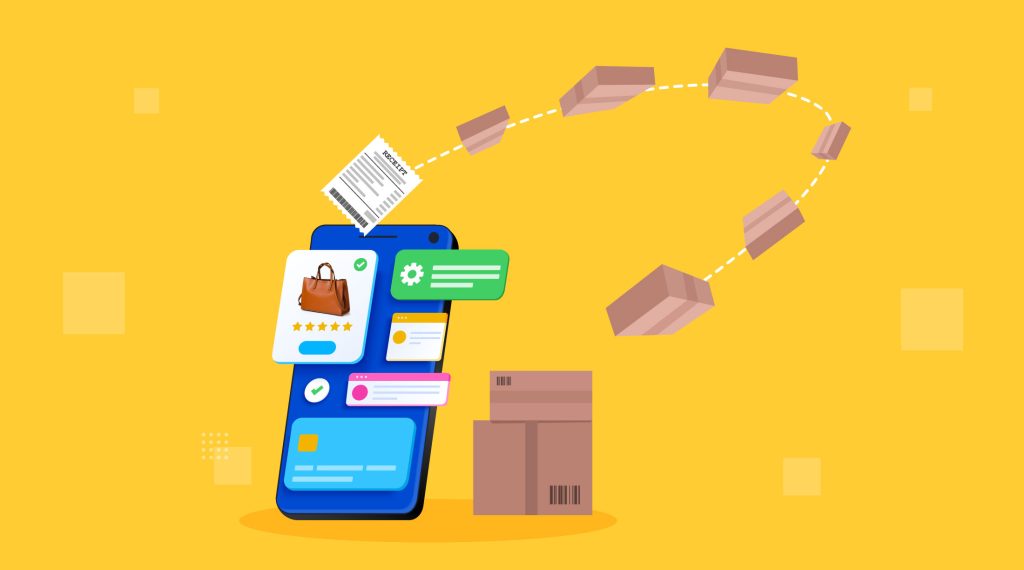The digital frontier is a bustling bazaar, replete with virtual stores, carts, and the clamor of intangible commerce. And yes, you guessed it right—we’re talking about ecommerce. For anyone curious about how to carve a niche in the ever-expanding online market, this article serves as your guide. We’ll delve into various facets, from defining what ecommerce is to exploring its different types and how it’s shaping the modern business landscape.
The Fundamental Anatomy of Ecommerce
Long gone are the days when commerce merely meant physical stores and face-to-face transactions. What is e-commerce, you may ask? It’s a digital marketplace where buying and selling happen in the realm of zeros and ones. Beyond simply a way to shop, it’s a multi-layered ecosystem involving supply chain management, digital payment systems, and marketing strategies—all interconnected through the World Wide Web.
The realm of ecommerce is expansive, incorporating diverse avenues like B2B, B2C, C2C, and even C2B. The market is so diverse that it houses everything from small Etsy vendors to retail giants like Amazon and Alibaba. In essence, it’s a melting pot of opportunities and ideas, and it’s worth noting how its basic structure is vastly different from traditional commerce.
Not limited by geographical borders or store timings, ecommerce offers a convenience that’s unparalleled. It also provides small businesses the platform to compete with big fish in the market. If you have an idea and the gumption to see it through, ecommerce opens up avenues previously unimaginable.
However, with the boons come the banes. Phishing scams, digital fraud, and data breaches are among the darker aspects you’d find here. It’s essential to understand these aspects for a comprehensive idea of what ecommerce entails.
Moreover, ecommerce isn’t just for products. A plethora of services are also traded, widening the scope even further. In essence, when you think about ecommerce, think big, for its possibilities are endless.

Demystifying the Types
Ecommerce examples abound, but understanding the types could be crucial in figuring out your niche. Broadly, it’s classified into four main categories:
- B2C: Business to Consumer is the most straightforward category. Companies like Amazon and eBay dominate this space, providing an endless array of products directly to consumers.
- B2B: Business to Business is where one business sells to another. Wholesale markets and SaaS platforms are classic examples here.
- C2C: Consumer to Consumer might make you think of eBay or Craigslist, platforms that allow consumers to sell to each other. The method is incredibly democratic and offers the individual a shot at entrepreneurship.
- C2B: Consumer to Business is the disruptive cousin. This is where individual consumers offer products or services to businesses. Freelance platforms like Upwork or Fiverr are perfect e-commerce examples here.
To specialize, you must identify your audience and customize your offerings accordingly. For instance, B2B businesses will have different marketing strategies and website interfaces compared to B2C ones.
Building Blocks: Setting Up an Ecommerce Business
Curious about what an e-commerce business is? Well, it’s not just a website with a catalog. Planning, inventory, customer service, payment gateways, and much more constitute this complex structure. Before diving in, it’s essential to lay down the building blocks carefully.
Identifying your niche market, studying the competition, and choosing the right technology stack are foundational steps. Business planning and strategy also involve legal formalities like licenses, taxes, and adherence to ecommerce laws.
You’ll also have to strategize your sales funnel, build or buy your ecommerce platform, and design the user interface for maximum impact. Use data analytics to assess customer behavior and trends. A smooth logistics chain, starting from warehousing to order fulfillment, needs to be in place.
Ecommerce business examples can range from small stores that sell hand-made crafts to massive, AI-driven platforms with real-time analytics. The scope and scale may vary, but the essential building blocks remain the same.
Your marketing strategy should employ SEO, email marketing, and social media. Add customer reviews and testimonials as social proof, which can be an essential conversion tool.
The backend must support the front-end operations, and it often involves a complex web of activities like database management, security checks, and order processing. Choose the right ecommerce platform that aligns with your business model and size.

The Market Mavericks: Ecommerce Leaders
Among ecommerce examples, a few industry leaders serve as inspirations. Amazon revolutionized the online marketplace with its customer-centric model and Prime service. Alibaba stands as an enormous B2B portal, connecting suppliers and buyers globally.
Then there’s Shopify, a game-changer that democratized ecommerce, providing anyone with the tools to set up a store. Walmart’s online shift is another perfect example of traditional retail giants adapting to the new normal.
These giants didn’t just create online stores; they revolutionized the way ecommerce is conducted. Understanding their strategies, marketing techniques, and customer engagement models will give you invaluable insights.
These leaders are masters of customer experience, employing AI and big data to personalize offers. Their supply chain management is often state-of-the-art, ensuring fast and accurate deliveries.
Their success stories make one thing clear—innovation and customer satisfaction are at the heart of ecommerce success. So, whether you’re a budding entrepreneur or an established business, keeping an eye on these giants can offer essential lessons.
What Powers the Ecommerce Engine: Technologies
You might wonder, how ecommerce works? The answer lies in technology. It’s the backbone supporting every online transaction, chatbot, and product recommendation. SSL certificates, secure payment gateways, and firewalls form the first line of defense against cyber threats.
Ecommerce platforms like Magento, Shopify, and WooCommerce have simplified setting up online stores. They offer ready-to-use templates, integrated payment solutions, and SEO-friendly structures.
Blockchain is another technology that’s set to redefine ecommerce, offering a secure and transparent way to conduct online transactions. Then there’s Augmented Reality (AR), enhancing the online shopping experience by allowing virtual try-ons and product previews.
Big data analytics play a crucial role in understanding consumer behavior, allowing businesses to tailor their strategies accordingly. Even AI has made its mark with chatbots for customer service, automated warehouses, and data-driven personalized recommendations.
Therefore, understanding and embracing the right technologies are crucial for your ecommerce venture to be future-proof.

Ecommerce Revenue Models: Show Me the Money!
When it comes to monetization, what is ecommers all about? While sales might be the primary source of revenue, multiple channels can add to the financial coffers.
Subscription-based models, like Amazon Prime, offer a steady income and enhanced customer loyalty. Affiliate marketing can be another income stream, providing commissions for product recommendations. Offering premium services, like expedited shipping or exclusive product ranges, can also increase revenue.
Another model is the freemium strategy, where basic services are free, but premium features require payment. This is common in SaaS ecommerce platforms, where basic templates may be free, but advanced features come at a price.
Data is another valuable asset. By anonymizing and aggregating customer data, you can provide valuable insights to market researchers and earn revenue. However, remember to adhere strictly to privacy laws like GDPR.
Understanding your customer base and testing different revenue models can help you identify the most lucrative option.
The Ecommerce Universe: Expanding Beyond Products
Ecommerce isn’t confined to physical goods alone. Which is an example of e-commerce beyond traditional products? Think digital downloads, software, streaming services, and even educational courses.
Take, for example, platforms like Udemy or Coursera. These are prime examples for ecommerce, offering intangible products—knowledge, in this case. Ebooks, digital art, and downloadable software are other avenues where ecommerce thrives.
Subscriptions for services like Netflix and Spotify also fall under the ecommerce umbrella. Even travel bookings and hotel reservations conducted online qualify as ecommerce transactions.
So if you’re contemplating an ecommerce venture, think beyond the tangible. The digital realm offers an arena where even ideas and skills can be commodities.
Ecommerce Marketing: Beyond the Basics
Just having a functional online store is not enough. What are e-commerce marketing strategies to get your business soaring? There’s more to it than mere product listings and flashy banners.
SEO is paramount. Organic search remains one of the most significant sources of online traffic. Creating quality content that answers consumer questions can boost your search engine rankings. Paid search marketing, like PPC ads, can also augment your visibility online.
Social media isn’t just for selfies and memes. Platforms like Facebook, Instagram, and Pinterest are robust sales channels when used correctly. Influencer collaborations can give your products the spotlight they deserve.
Email marketing is one of the oldest yet most effective strategies. A well-crafted email can lead to high conversion rates. It’s also crucial for retargeting and customer retention.
Lastly, never underestimate the power of customer reviews and testimonials. They serve as invaluable social proof, reassuring new customers about the quality of your products or services.

What Makes It Tick: Customer Experience
When it comes to what is e-commerce in business, customer experience often separates the successful ventures from the failures. Offering a seamless, enjoyable shopping experience is as crucial as the quality of your products.
User-friendly website design, straightforward navigation, and an uncomplicated checkout process can make or break a sale. A secure payment gateway reassures customers, while fast loading speeds prevent them from bouncing off your site.
Customer service is another cornerstone. Quick responses to queries, an easy return policy, and transparent business practices contribute to a satisfying customer experience. Incorporating features like chatbots, FAQ sections, and customer reviews can significantly elevate user experience.
Moreover, a personalized experience can significantly boost customer loyalty. Using data analytics, you can offer product recommendations, personalized discounts, and targeted email campaigns, making each customer feel special.
The ultimate goal is to make the customer’s journey from browsing to checkout as smooth as possible, increasing not just sales, but also customer retention and loyalty.
The Road Ahead: Future Trends
With the rapid advancements in technology and shifts in consumer behavior, what is ecommerce business examples today might not even exist tomorrow. The realm of ecommerce is ever-evolving, and keeping up with the latest trends is essential for sustained success.
Sustainability is a buzzword that’s making its way into ecommerce, with more businesses adopting eco-friendly practices. Drone deliveries, automated warehouses, and even virtual shopping assistants powered by AI are on the horizon.
Voice search is another upcoming trend, thanks to the increasing use of voice-activated devices like Alexa and Google Home. Businesses will have to adapt their SEO strategies to stay ahead in this new paradigm.
Subscription-based models are expected to proliferate, providing businesses with more predictable revenue streams. Cryptocurrency, although still a nascent concept in ecommerce, could become a mainstream payment method.
What’s evident is that ecommerce will continue to evolve, offering new opportunities and challenges alike. Businesses that adapt, innovate, and prioritize customer satisfaction will be the ones that thrive in this dynamic landscape.

The Importance of Analytics: Making Data-Driven Decisions
The aphorism “knowledge is power” holds especially true in the realm of ecommerce. Without the proper data and analytics, even the most well-intentioned efforts could end up being misguided. This is where the role of analytics comes into play, forming the backbone of any successful ecommerce venture.
Firstly, analytics can help you understand your audience better. Knowing who your customers are, what they prefer, and how they behave online is crucial for crafting targeted marketing campaigns. With tools like Google Analytics or specialized ecommerce analytics software, you can track metrics such as user engagement, bounce rate, and conversion rate. These insights allow for data-driven decision-making, which is often more reliable than intuition or guesswork.
Secondly, analytics provide invaluable feedback on the performance of your website and campaigns. Are customers leaving at the checkout page? Is a particular product page receiving unusually low traffic? Answers to such questions can highlight bottlenecks or weak links in your ecommerce chain. Once identified, these issues can be systematically addressed, enhancing user experience and, in turn, profitability.
Lastly, predictive analytics can offer you a glimpse into the future. Utilizing machine learning algorithms and historical data, predictive models can forecast sales trends, customer behaviors, and even the potential success of upcoming marketing campaigns. This sort of forward-looking analysis can be the edge that sets you apart from competitors, enabling proactive measures rather than reactive responses.
Conclusion
Navigating the vast seas of ecommerce can be both exhilarating and daunting. However, understanding its intricate layers—from what it is at its core to the technologies that power it—can equip you with the oars to steer through these digital waters successfully. As the ecommerce landscape continues to evolve, being aware of the fundamentals, trends, and best practices can give you the competitive edge you seek. So here’s to setting sail on your ecommerce journey—may your carts be ever full, and your returns minimal!


